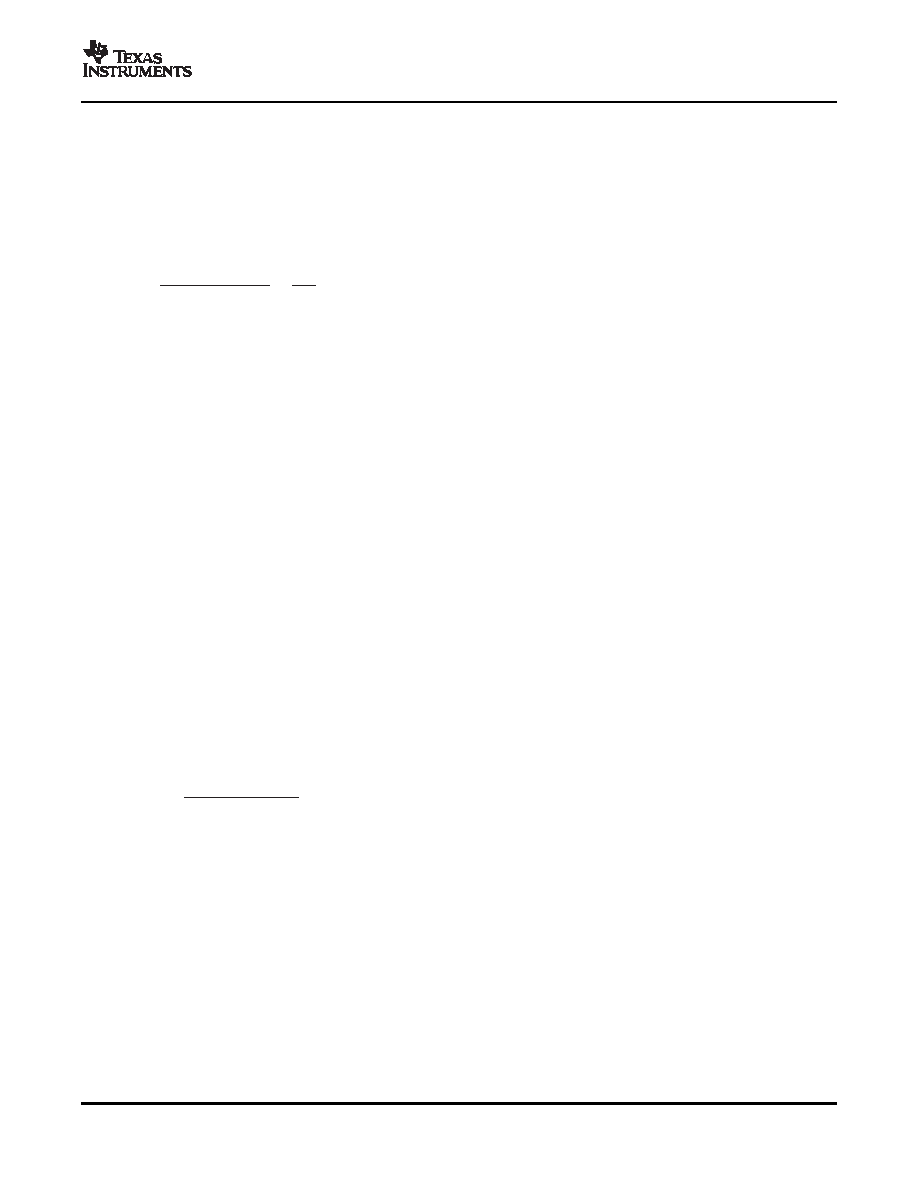- 您現(xiàn)在的位置:買賣IC網(wǎng) > PDF目錄98282 > TPS51511RHLT (TEXAS INSTRUMENTS INC) SWITCHING CONTROLLER, 350 kHz SWITCHING FREQ-MAX, PQCC20 PDF資料下載
參數(shù)資料
| 型號(hào): | TPS51511RHLT |
| 廠商: | TEXAS INSTRUMENTS INC |
| 元件分類: | 穩(wěn)壓器 |
| 英文描述: | SWITCHING CONTROLLER, 350 kHz SWITCHING FREQ-MAX, PQCC20 |
| 封裝: | ROHS COMPLIANT, PLASTIC, QFN-20 |
| 文件頁數(shù): | 11/29頁 |
| 文件大?。?/td> | 1019K |
| 代理商: | TPS51511RHLT |
第1頁第2頁第3頁第4頁第5頁第6頁第7頁第8頁第9頁第10頁當(dāng)前第11頁第12頁第13頁第14頁第15頁第16頁第17頁第18頁第19頁第20頁第21頁第22頁第23頁第24頁第25頁第26頁第27頁第28頁第29頁

www.ti.com
0 +
1
2p
ESR
Co
v
sw
3
(20)
Thermal Design
W
DSRC + VVLDOIN * VVLDO
I
VLDO
(21)
V
PKG +
T
J(max) * TA(max)
q
JA
(22)
SLVS735A – FEBRUARY 2007 – REVISED APRIL 2007
APPLICATION INFORMATION (continued)
The VOSW voltage is compared with the internal reference voltage from the divider resistors. The PWM
comparator determines the timing to turn on the top MOSFET. The gain and speed of the comparator is high
enough to keep the voltage at the beginning of each on cycle (or the end of off cycle) substantially constant. The
DC output voltage may have line regulation due to ripple amplitude that slightly increases as the input voltage
increases.
To ensure loop stability, the 0dB frequency, f0, defined below, should be lower than 1/3 of the switching
frequency.
Because f0 is determined solely by the output capacitor’s characteristics, the loop stability of D-CAP Mode is
determined by the capacitor’s chemistry. For example, specialty polymer capacitors (SP-CAP) have Co in the
order of several-hundred
F and ESR values in the range of 10 m. These will make f
0 approximately 100 kHz
or less, and the loop will be stable. However, ceramic capacitors have f0 at more than 700 kHz, which is not
suitable for this mode.
D-CAP mode provides many advantages such as ease-of-use, minimum external component count and
extremely short response time. However, because it does not employ an error amplifier in the loop, a sufficient
amount of feedback signal must be provided by the external circuit to reduce jitter level. A good layout which
follows the layout considerations in this data sheet also can reduce the jitter level.
Components selection is much simpler in D-CAP mode.
1. Choose inductor.
This section is the same as the current mode. Refer to the instructions in the Current Mode Section.
2. Choose output capacitor(s).
Organic semiconductor capacitor(s) or specialty polymer capacitor(s) are recommended.
The primary power dissipation of TPS51511 is generated from the LDO. The potential difference between
VLDOIN and VLDO times LDO current gives the power dissipation, WDSRC,
Another power consideration is the current used for internal control circuitry from the V5IN supply. V5IN supports
both the internal circuitry and the external MOSFET drive current.
These powers need to be effectively dissipated from the package. Maximum power dissipation allowed to the
package is calculated by,
Where:
TJ(max) is 125°C
TA(max) is the maximum ambient temperature in the system
θ
JA is the thermal resistance from the silicon junction to the ambient
This thermal resistance strongly depends on the board layout. TPS51511 is assembled in a thermally enhanced
PowerPAD package that has an exposed die pad underneath the body. For maximum thermal performance, this
die pad must be attached to a ground trace via a thermal land on the PCB. This ground trace acts as a heat
sink. The typical thermal resistance, 53.3
°C/W, is achieved based on a 3,05 mm × 2,05 mm thermal land with 6
vias without air flow. It can be improved by using a larger thermal land and/or increasing the number of vias.
Further information about PowerPAD and its recommended board layout is described in a Texas Instruments
19
相關(guān)PDF資料 |
PDF描述 |
|---|---|
| TPS53114PW | SWITCHING CONTROLLER, 700 kHz SWITCHING FREQ-MAX, PDSO16 |
| TPS53114PWR | SWITCHING CONTROLLER, 700 kHz SWITCHING FREQ-MAX, PDSO16 |
| TPS53114PWP | SWITCHING CONTROLLER, 700 kHz SWITCHING FREQ-MAX, PDSO16 |
| TPS53127RGER | DUAL SWITCHING CONTROLLER, 700 kHz SWITCHING FREQ-MAX, PQCC24 |
| TPS53127RGET | DUAL SWITCHING CONTROLLER, 700 kHz SWITCHING FREQ-MAX, PQCC24 |
相關(guān)代理商/技術(shù)參數(shù) |
參數(shù)描述 |
|---|---|
| TPS51511RHLTG4 | 功能描述:DC/DC 開關(guān)控制器 Synch Switcher Cntrlr RoHS:否 制造商:Texas Instruments 輸入電壓:6 V to 100 V 開關(guān)頻率: 輸出電壓:1.215 V to 80 V 輸出電流:3.5 A 輸出端數(shù)量:1 最大工作溫度:+ 125 C 安裝風(fēng)格: 封裝 / 箱體:CPAK |
| TPS51513 | 制造商:TI 制造商全稱:Texas Instruments 功能描述:SINGLE PHASE D-CAP+ SYNCHRONOUS BUCK CONTROLLER WITH INTEGRATED DRIVERS FOR GENERAL IC VCORE APPLICATIONS |
| TPS51513EVM-549 | 功能描述:電源管理IC開發(fā)工具 TPS51513EVM-549 Eval Mod RoHS:否 制造商:Maxim Integrated 產(chǎn)品:Evaluation Kits 類型:Battery Management 工具用于評估:MAX17710GB 輸入電壓: 輸出電壓:1.8 V |
| TPS51513EVM-549 | 制造商:Texas Instruments 功能描述:DEVELOPMENT TOOL |
| TPS51513RHB | 制造商:TI 制造商全稱:Texas Instruments 功能描述:SINGLE PHASE D-CAP+ SYNCHRONOUS BUCK CONTROLLER WITH INTEGRATED DRIVERS FOR GENERAL IC VCORE APPLICATIONS |
發(fā)布緊急采購,3分鐘左右您將得到回復(fù)。